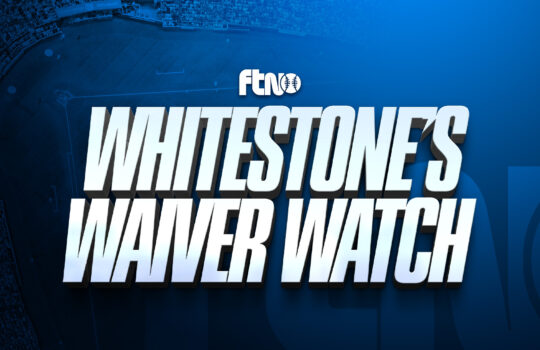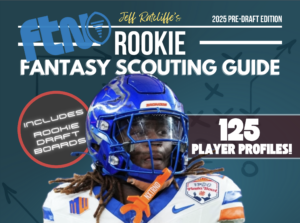
Whether you’re new to DFS as a whole, new to MLB DFS specifically, or a savvy MLB DFS vet looking to improve your process, FTN has what you’re looking for. A combination of models and tools, daily slate-specific articles and livestreams, and evergreen strategy articles results in an all-encompassing product that allows you to pick and choose how to best benefit from the plethora of content.
Where to Begin
MLB DFS has two major components — pitching and hitting. As such, we have two foundational models to our product: a pitching model by yours truly and a HR rater/stack model from Kyle Murray. Let’s dive into everything you should know about these models including how they’re produced and how you can best utilize them.
The Pitching Model
The uniqueness of the pitching model is not what goes into it (mostly common advanced stats and rates for both the pitcher and hitters), but what it spits out. The DK projection is worthwhile to look at, but given the variance of MLB DFS, perhaps the most important and useful feature is the threshold probabilities — the percent chance that the pitcher will reach at least 10, 15, 20, 25 and 30 DK points. Often two pitchers will have similar projections, but one will have a clear advantage through the full range of outcomes.
When considering price and ownership, the full range of outcomes is more important to consider than the mean outcome.
Lastly, it’s worth noting that the model does in fact use one unique input. I found pitches per inning to be extremely predictive of DFS performance. This is just speculation, but I believe the reason for this is twofold — first, efficiency in this metric allows a pitcher to go deep into games, accruing extra fantasy points. Second, however, I believe there is signal here for the potential for an increased K rate moving forward. Joe Musgrove is a perfect example — he was the single most efficient pitcher from a pitches-per-inning standpoint in 2018 and 2019 with a K rate hovering between 20% and 22%. In 2020, his K rate jumped to an enormous 33% as he began to try and miss more bats, leading to more pitches per inning.
The Stack Model & HR Rater
Similar to the process behind the pitcher model, Kyle incorporates a wide array of advanced stats from both the pitcher and hitters to evaluate the matchups. He then combines the individual matchups to evaluate the outlook of each team. In his own words, the stack ratings are then a combination of ceiling potential, ownership, and resulting leverage. To sum it up, he’s wicked sharp.
That’s especially clear in his HR rater, which uses predictive metrics of power prevention for the pitcher and power production for the hitters with simulated data to predict where HRs are most likely to come in bunches.
Supplementary Tools
In addition to these foundational models, we offer a wide array of tools to further improve and streamline your process. I recommend exploring them all, but of special note is the umpire report. Every MLB DFS player has been on the wrong side of their pitcher getting squeezed on a would-be strikeout, only to allow a home run on the next pitch — or a hitter with the bases loaded striking out looking on a ball six inches outside. It always feels like terrible luck, but the truth is we can ensure we’re on the right side of this luck more often than not by considering who’s behind the plate.
Core to the FTN Daily experience are the cheat sheets. Our analysts input our favorite plays, ranked for each slate. These rankings and exposures are then aggregated for your convenience. In a way, the cheat-sheets are a perfect representation for the MLB subscription as a whole. They provide instant value and streamline your process.
One other unique addition this season — though not live yet, we will soon have a tool that displays pitch-mix matchups. For example, let’s say the opposing pitcher throws a fastball or slider on 90% of his pitches. You’ll know which hitters crush these pitches and which hitters struggle vs them with a single click.
DFS Necessities
The DFS product would be incomplete without rostership projections (more on rostership in a bit) and an optimizer. The power of the FTN Optimizer is truly incredible, as it gives you flexibility to generate 150 lineups that you would build by hand with unlimited time and energy. Kyle broke down how to use the optimizer for NFL lineups and the vast majority of it translates to MLB, as well.
Evergreen Content
This is a perfect segue to the final thing we offer at FTN — evergreen content. For example, this week I discussed the importance of ownership and why it should be at the center of your MLB GPP lineup building process. Similarly, Kyle’s Opening Day piece is filled with nuggets on the type of data that is and will continue to be predictive, while teaching you how to dismiss the “data” that isn’t.
Daily Content
Last but certainly not least is our daily content. We will have multiple articles each day, including our flagship GPP article, “The Sweet Spot.” One goal we have this season is to be more aggressive with our content, recommending specific stands so that when we crush, you crush. These stands will be further discussed in our daily live streams, which will consist of discussion surrounding both slate-specific plays and general strategy.
The last point that I think is worth noting is this — it’s entirely OK to feel overwhelmed at the start of the season. Take your time and be patient. You’ll begin to find a rhythm soon and your process will become clearer and more efficient each day. You’ll also learn which pieces of content you find the most value from for your specific contests and strategy. Let’s have a blast together this season.
















































 New York Jets
New York Jets  New England Patriots
New England Patriots  Miami Dolphins
Miami Dolphins  Buffalo Bills
Buffalo Bills  Pittsburgh Steelers
Pittsburgh Steelers  Cleveland Browns
Cleveland Browns  Cincinnati Bengals
Cincinnati Bengals  Baltimore Ravens
Baltimore Ravens  Tennessee Titans
Tennessee Titans  Jacksonville Jaguars
Jacksonville Jaguars  Indianapolis Colts
Indianapolis Colts  Houston Texans
Houston Texans  Las Vegas Raiders
Las Vegas Raiders  Los Angeles Chargers
Los Angeles Chargers  Kansas City Chiefs
Kansas City Chiefs  Denver Broncos
Denver Broncos  Washington Commanders
Washington Commanders  Philadelphia Eagles
Philadelphia Eagles  New York Giants
New York Giants  Dallas Cowboys
Dallas Cowboys  Minnesota Vikings
Minnesota Vikings  Green Bay Packers
Green Bay Packers  Detroit Lions
Detroit Lions  Chicago Bears
Chicago Bears  Tampa Bay Buccaneers
Tampa Bay Buccaneers  New Orleans Saints
New Orleans Saints  Carolina Panthers
Carolina Panthers  Atlanta Falcons
Atlanta Falcons  San Francisco 49ers
San Francisco 49ers  Seattle Seahawks
Seattle Seahawks  Los Angeles Rams
Los Angeles Rams  Arizona Cardinals
Arizona Cardinals 










 Boston Celtics
Boston Celtics  Brooklyn Nets
Brooklyn Nets  Philadelphia 76ers
Philadelphia 76ers  New York Knicks
New York Knicks  Toronto Raptors
Toronto Raptors  Chicago Bulls
Chicago Bulls  Detroit Pistons
Detroit Pistons  Milwaukee Bucks
Milwaukee Bucks  Cleveland Cavaliers
Cleveland Cavaliers  Indiana Pacers
Indiana Pacers  Orlando Magic
Orlando Magic  Atlanta Hawks
Atlanta Hawks  Charlotte Hornets
Charlotte Hornets  Miami Heat
Miami Heat  Washington Wizards
Washington Wizards  Denver Nuggets
Denver Nuggets  Minnesota Timberwolves
Minnesota Timberwolves  Oklahoma City Thunder
Oklahoma City Thunder  Portland Trail Blazers
Portland Trail Blazers  Utah Jazz
Utah Jazz  LA Clippers
LA Clippers  Golden State Warriors
Golden State Warriors  Los Angeles Lakers
Los Angeles Lakers  Phoenix Suns
Phoenix Suns  Sacramento Kings
Sacramento Kings  Dallas Mavericks
Dallas Mavericks  Houston Rockets
Houston Rockets  Memphis Grizzlies
Memphis Grizzlies  New Orleans Pelicans
New Orleans Pelicans  San Antonio Spurs
San Antonio Spurs 









